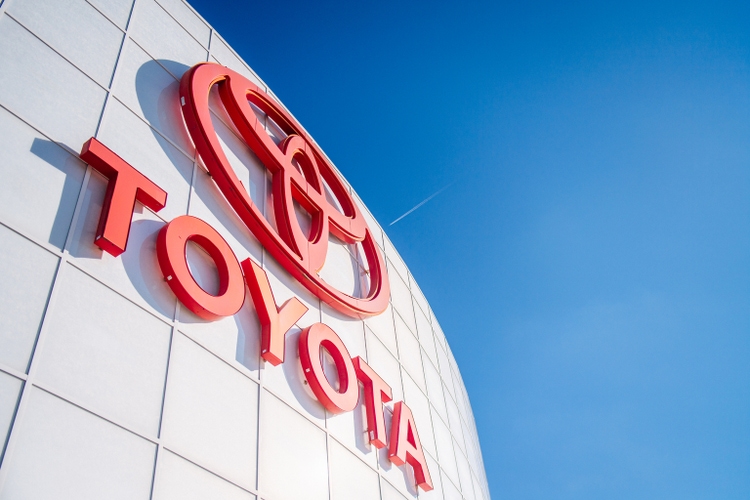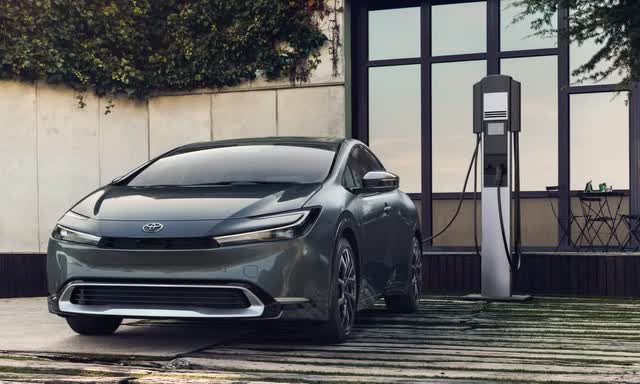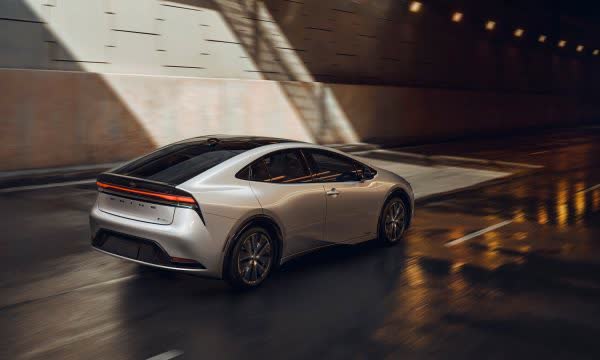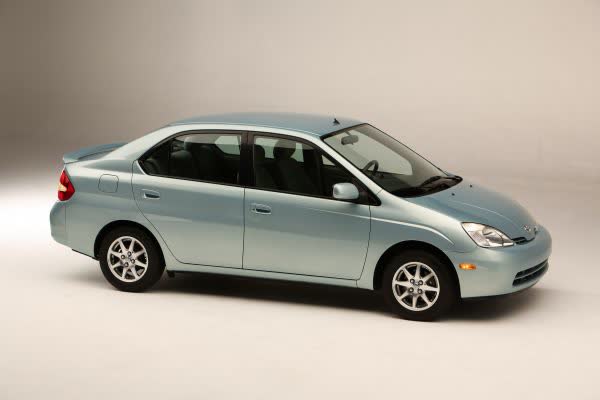
Brandon Bell/Getty Images News
Toyota’s (NYSE:TM) fifth generation of its Prius sedan – the original version introduced 25 years as a radical answer for achieving fuel economy – probably won’t change many decided minds about the best approach to de-carbonizing the world.
The new Prius, shown first this week in Tokyo and subsequently in Europe and Los Angeles, remains a gas-electric hybrid with a vastly improved exterior design, and is more powerful than its predecessor, without giving up fuel economy that’s among the stingiest on the planet.

2023 Prius Prime plug-in (Toyota Motor)
The 2023 Prius will be accompanied by a Prius Prime version, a plug-in hybrid that upgrades to a lithium-ion battery and provides roughly 35 miles of pure electric range. The 1.8-liter engine was ditched in favor of a 2.0-liter.
Soured on Toyota
Among many clean-air activists, Toyota – once a darling of the environmental movement – has betrayed the cause of carbon reduction because it exercises caution with regard to developing and selling BEVs. Because many consumers are wary of BEVs or can’t afford their premium price, Toyota reasons that vehicles like Prius – which will be rated at about 57 miles per gallon of gasoline – will sell in greater number than BEVs and therefore make more sense.

2023 Toyota Prius (Toyota Motor)
In its defense, Toyota emphasizes its leadership in fuel economy, arguing that reducing emissions across the board with gas-electric hybrids actually results in less CO2 emitted into the atmosphere than by building BEVs, which would consume more of the scarce resources and minerals needed to build batteries and which a smaller number of customers would buy.
“For me, playing to win also means doing things differently. Doing things that others may question, but that we believe will put us in the winner’s circle the longest,” said Akio Toyoda last month during Toyota’s annual dealer meeting in Las Vegas.
Toyoda said he does not think BEVs will be adopted as quickly as policy regulators and rival automakers presume. The reasons: Lack of charging infrastructure, premium pricing and the variety of customer preferences region to region.
Across the line
Whereas Toyota once offered gas-electric hybrid powertrains – which do need a battery – only in Prius models, today hybrid powertrains are available across the entire Toyota and Lexus model lineup. Toyota has sold about 20 million gas-electric hybrids among 20 or so models.
In my opinion, Toyota’s position is a strong one because the resources for manufacturing batteries that power BEVs are demonstrably limited and will remain limited for years – possibly until new technologies, such as solid-state batteries and hydrogen, become practical. Assuming this is the case, why not continue to improve hybrid technology?
Toyota, which endured skepticism and ridicule from rival automakers for its original gas-electric Prius, has always developed strategies with an eye to the long term, part of why it has grown to be the world’s top automaker in terms of sales (10.5 million vehicles sold in 2021) and profit.

2023 Prius (Toyota Motor)
In its heyday Prius was the No. 1 selling model in California. Larry David famously drove it in Curb Your Enthusiasm. Prius’s popularity has declined since then, prompting Toyota for its latest generation to replace its deliberately utilitarian and frumpy styling for a sleek and handsome design. The original idea for a distinctive no-frills look was to signal Prius’s seriousness as a fuel miser – but since the rest of Toyota’s lineup now also features hybrids, the decision came down to treat Prius to a makeover.

Original 2000 Prius (Toyota)
Toyota’s TNGA-C platform allowed engineers to move the battery from under the trunk to under the back seat. The redesign opened up storage space in the trunk and lowered the center of gravity, which improved handling.
The new exterior design maintains an aerodynamic profile, important for fuel economy, though in a much more eye-catching manner than previously. The interior is thoroughly modern, with a few of the lines, materials, screens and controls borrowed from Toyota’s bz4X BEV, introduced earlier this year.
The new version is quicker, accelerating from 0-60 mph in 6.7 seconds, up from about 10 seconds for the current model.
Power up
“We wanted to show we could maintain the efficiency and see a jump in performance,” Toyota Chairman Takeshi Uchiyamada told trade publication Automotive News.
The Prius Prime plug-in version provides up to 50% more pure-electric range than the current model’s 25 mile limit. For some customers, this will prove plenty if the vehicle is used close to home and can be recharged overnight – it won’t do much good for road trips. An available feature will be solar panels on the roof that can recharge the car’s battery for gasoline-free driving.
For the time being, Toyota executives say, Prius will be manufactured in Japan. But uncertainties over federal and state incentives for certain emission-free vehicles such as Prius Prime may mean a transfer of production to the U.S.
Toyota also showed a concept version of its bz SUV, likely the next BEV to be offered in the U.S.
Toyota’s sales and earnings have been depressed for the past two years for the same reasons that have pushed down the results of other global automakers: Supply-chain and semiconductor-related shortages that have trimmed inventories. Executives say the situation is improving though vehicle stocks have not yet returned to pre-pandemic levels.
Toyota’s ADRs have been knocked down in price from about $212 a share at the beginning of 2022 to the current level of about $140 – a drop of 34% – reflecting a current P/E of about 11 and a dividend yield of 1.76%. The fall in price may also echo, to a lesser degree, some negativity from critics urging a speedier electrification strategy.
In my view, the current price reflects an attractive entry point for Toyota shares. The automaker’s long-term, conservative and steady performance isn’t likely to produce spectacular results for investors in the short term. Like Toyota’s view on electrification, its share will one day be seen as under-appreciated and undervalued.


Be the first to comment